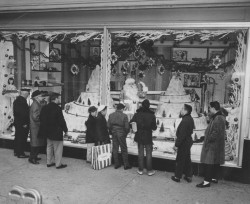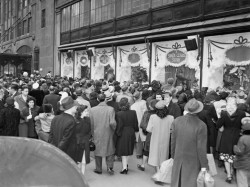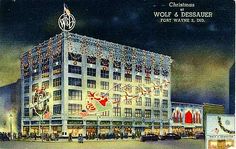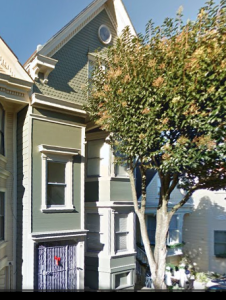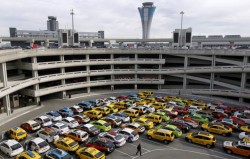Tag Archives: James Hanley
It began with Wolf and Dessauer. In the years before shopping malls and chain retail stores, Wolf and Dessauer was where Fort Wayne shopped. A purely local department store, it made its name as a place that was not just for shopping, but twas a social experience, with high levels of customer service, lounging rooms for tired shoppers, and access to telephones for people who who did not yet have one at home.
And Christmas was (so I hear; it was before my time) a magical time at W&D. They were famous for their magic windows, which some say were the equal of Macy’s.
In 1937 W&D hung a 25 foot wreath containing a reported 40,000 lights from the side of the building. Then in 1940 they constructed a 51 yard long display of Santa and his reindeer . Made of wood and containing (depending on which of the many unverified sources one believes) between 24,000 and 40,000 lights. It took workers several weeks to hang it, using blocks and tackles to haul the pieces manually up the side of the building.
 The display was only up for two years before WWII intervened, with demands for reductions in energy usage and night-time blackout requirements. (Fort Wayne was, and is, an important industrial city, and apparently officials were worried the Germans might sneak across the Atlantic and 700 miles of U.S. territory without being detected to bomb armament factories.) Shut down for three years, the display returned in 1945, a joyous symbol of the end of war.
The display was only up for two years before WWII intervened, with demands for reductions in energy usage and night-time blackout requirements. (Fort Wayne was, and is, an important industrial city, and apparently officials were worried the Germans might sneak across the Atlantic and 700 miles of U.S. territory without being detected to bomb armament factories.) Shut down for three years, the display returned in 1945, a joyous symbol of the end of war.
Santa and the wreath were displayed for 14 years, then put into storage when Wolf and Dessauer moved to a new building, and was not put up again the next Christmas.
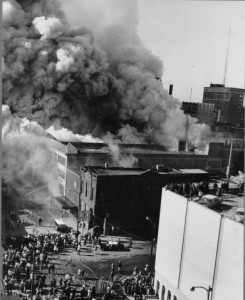 In 1962 the old building was destroyed in one of the largest fires in Fort Wayne history. As firefighters struggled against large crowds and freezing weather that froze the spray from their firehoses, five buildings were damaged or destroyed, and at least one fireman lost his life.
In 1962 the old building was destroyed in one of the largest fires in Fort Wayne history. As firefighters struggled against large crowds and freezing weather that froze the spray from their firehoses, five buildings were damaged or destroyed, and at least one fireman lost his life.
In 1966 Wolf and Dessauer sold their business to City Stores, a Delaware-based retail store holding company, and in 1969 City Stores sold W&D to Indianapolis-based department store chain L.S. Ayres. (See the subsequent history of Ayres below.*) L.S. Ayres had a store at the newly opened Glenbrook mall, then on the edge of the city, and in the early 1970s closed the downtown store.
My mother says she used to take my siblings and me to W&D to see the magic windows and sit on Santa’s lap every year before the store closed. Unfortunately I have only the very faintest memories of that, wholly without detail, and perhaps they’re really only memories of being told that we did that. And while my oldest brother and sister might have seen the Santa display as infants, it was already several years gone before I was born. But for older people, the Wolf and Dessauer Santa and wreath were among their most nostalgic memories.
For 20 years, longer than the original Santa had flown across the W&D store, and only a few years less than the wreath had hung there, the displays were lost. Or perhaps their location was known all along, but nobody was interested in reviving them. Or more likely, perhaps, the owners of W&D decided not to redisplay them after the move, and then as the company was sold and re-sold and old-timers of the company left the knowledge of the displays’ location was not passed on, and the new owners, managers actually, no longer locals but corporate types in distant cities, knew nothing of them and might not have cared if they did. They were running regional and national firms, not a local one.
Whatever the real story, in the spring of 1979 the displays were serendipitously discovered in a warehouse. That Christmas, two restored reindeer were displayed on the side of a downtown parking garage. In 1980, the whole display was lit for the first time since 1959, and has been displayed every year since. 2015 makes the 36th year of continuous display in its second incarnation, twice as long as its original display, and closing in on as many years as it was first displayed and then lost combined.
Today the historic Embassy Theater–a grand movie palace from the 1920s, now operated by a non-profit foundation–creates magic windows. Probably never again can we recapture the experience of a Wolf and Dessauer Christmas, but it’s still a wondrous experience to take my kids to see them. It’s a part of Fort Wayne that is special–beautiful, dazzling, historical, and evocative of the connections between past and present, all the more precious because they were once lost.

And today many of us have a bit of this history decorating our own homes at Christmas. In the mid 2,000s the tens of thousands of 11 watt bulbs were replaced with LEDs to save in energy costs (although three times the cost of the older bulbs, the LEDs were expected to pay for themselves in just two years). The old bulbs were given to charities to sell as Christmas ornaments. My Christmas gift from my mom that year was one of the old bulbs. It has hung on my Christmas tree every year since, and while my kids do the majority of the tree decorating (one of our annual gifts to them is an ornament each, and it’s great to watch them remember and reconnect with them each year), the bulb is one of the few ornaments I personally hang.
_____________________________
*Ayres was purchased by Associated Dry Goods of New York City in 1972, which then merged Ayres with the Cincinnati-based Pogues, keeping the Ayres name. In 1986 the May Department Store Company acquired Associated Dry Goods, and in 1987 Associated Dry Goods was renamed L.S. Ayres and Company. Ayres was then merged with St. Louis-based Famous-Barr (also owned by May) in 1991. In 2005, Federated Department Stores, which had previously purchased Macy’s, purchased the May company and merged Ayres into its Macy’s division, apparently ending the Ayres retail name.
Hillary Clinton, never one to miss an opportunity to pander, told a prospective Iowa voter that he had “a great idea,” in suggesting she appoint Obama to the Supreme Court.
It’s a terrible idea, and that has nothing to do with how I feel about Obama’s presidency, his character, or his qualifications for the job.
My friend Ed Brayton, who blogs at Dispatches from the Culture Wars, noted on Facebook that “Obama’s record on civil liberties and in cases before the Supreme Court is pretty terrible. I would have no faith in him as a justice.” He has been bad on civil liberties, but sometimes people change their perspective when they’re in a different position (c.f., Earl Warren). I’m not positive Obama would be a horrible civil liberties justice (although I’d be happier with the appointment of someone with a better track record, for sure).
Others might worry that Obama is too much of a leftist, because apparently there are people who still believe that. I don’t find that a serious concern. More pointedly, some might note that he doesn’t have any judicial experience, and that having been a part-time teacher of constitutional law isn’t the most impressive resume for a SCOTUS appointee. But of course it’s a fairly recent tradition that all appointees must have lengthy judicial experience, and one that appears to me to be largely driven by the American Bar Association’s inappropriate assumption of the role or arbiter of qualifications for a public office (and we worry about the Koch brothers!). Personally, I I think there are umpteen thousand Americans who are qualified for the job, and presidents’ talk about selecting “the best” person is 100% FDA Prime bullshit. And a little less technical lawyering and a little more understanding of the Constitution as more than a legal document–I’m looking at you, Tony Scals–wold be good.
But my overriding concern is the growth of presidential power. And one of the factors promoting that has been a Supreme Court that has been less eager to check presidents, and that–according to political scientists Matt Crenson and Ben Ginsberg in their book Presidential Power: Unchecked and Unbalanced–is at least in part because more and more Supreme Court justices have extensive background in the executive branch, rather than gaining experience elsewhere. They become enculterated in the concerns and needs of the executive, and more willing to give presidents some leeway, rather than trying to keep them in check.
Presumably, presidents have always appointed judges whom they found politically congenial. What has changed is that preisdnets no longer choose judicial appointees with legislative backgrounds, and the political milieu in which judges originate presumably affects their institutional affinities and sympathies. During the nineteenth century, federal judges typically emerged from the country’s electoral and representative systems. …
The fact that many federal judges had served, continued to serve, and often would serve again as legislators helped to reinforce legislative primacy by ensuring that the federal bench would hvae a certain respect and partiality for legislative institutions. …
Judicial deference to legislative power has practically disappeared today …
What has changed in recent decades is the character of judges’ political and governmental experience. Few recent or contemporary federal judges have ever served in a legislative body, but many have served in executive agencies or in federal or state judicial institutions…Today’s judges are recruited primarily from executive and judicial positions, not from legislatures. [pp.305-314]
Crenson and Ginsberg have a table showing the decline of federal judges with judicial experience from a high of almost 81% in 1830, to 38% in 1900–around the time presidential power began its upward trend–to 4% in 20005. We need fewer judges with executive backgrounds, not more, and certainly not one so deeply steeped in sympathy for the office of the presidency itself.
LBJ adviser George Reedy, in The Twilight of the Presidency regretted that the President has become so sheltered that there is no one to tell him “go soak your head” How likely is it that a Justice Obama would tell future presidents–not just a President Hillary Clinton, but a President Rubio, Cruz or Trump, too–to go soak their head?
While many Democrats are eager to deny that Trump is drawing support from their party, the data show a different story. That data also reveals the falsity of the pretense that Republican party leaders could somehow have prevented their party from being largely captured by an ugly populist contingent.
It’s important to remember that both parties have traditionally had their reactionary factions. While the GOP had the John Birchers, the Democrats had their boll weevils—socially conservative and racist southern Democrats, but who often supported populist initiatives, such as rural electrification. Not only did the Democrats have that group, that group was the foundational core of the Democratic Party, with its Jeffersonian origins in anti-nationalism and defense of a racially stratified society.
The boll weevils are mostly forgotten now, but not wholly gone. The South has shifted from being overwhelmingly Democratic to being highly contested territory where Republicans win regularly. In 1960, 100% of the U.S. Senate seats from the Confederate states were held by Democrats. In 1980 they still held 55% of those seats. Today, the Democrats only hold 18%. But Democrats are often more successful on the local level, where politics is more personal and party label less significant…and where people can know that Candidate Smith isn’t a liberal, but an old time Democrat. Many of these voters still identify as Democrat, even as they vote Republican at the state and national levels. Think, for example, of Kim Davis, the Tennessee County Clerk who refused to give out marriage licenses to same sex couple—a Democrat, not a Republican.
And those folks are often Trump supporters. Other than his home state of New York, Trump’s best states are in a bundle of the old South states plus West Virginia, another state where the old southern Dems long dominated. Out west in the intermountain states, which have always been predominantly Republican, )his support fades.
OK, one might say, they’re not real Democrats (although they are what Democrats predominantly once were), because they’re really conservatives. But as reported by RealClearPolitics, 20% of the Trumpenproletariate identify as liberal. True, a strong majority of 65% describe themselves as conservatives, but only 13% say they are very conservative, and less than 1/3 say they are Tea Partiers. Trump’s supporters are not the radical right-wing revanchists liberals claim are taking over the Republican Party.
All of this helps explain why over 2/3 of Trump’s supporters say they would vote for him if he left the GOP. A lot of them aren’t strongly committed to the party—they are in fact not the mythical Republican base.
Liberal and establishment Democrats don’t want to admit that many of these people are still Democrats. But many of them are, or they are about as much Democrats as they are Republican, willing to vote for either party depending on the candidate.
And this is the reason it’s ridiculous to talk about how the GOP establishment should have kept these people from taking over the party. First, they haven’t; that’s largely a different group of people. Second, parties don’t choose their supporters as much as supporters choose the party. If we think in spatial terms, on a left to right continuum, many of these people find themselves to the right of the median Democrat, so they’re going to take a look at the party that’s also to the right of the median Democrat. If they find that they’re also to the right of the median Republican, they’ll be more attracted to the Republican Party, not necessarily because it is welcoming to their extremist views, but because it’s median is less far away from their views than the Democratic median. Those folks will pull the party away from its establishment, but there’s precious little the establishment can do to stop that.
But those aren’t the Trumpa Loompahs (hattip Steve Horwitz). Those folks tend to support Cruz or Rubio, because they recognize the liberal elements in Trump’s message.
So suck it up, Dems. Trump’s your party’s phenomenon, too.
You may have seen the meme.
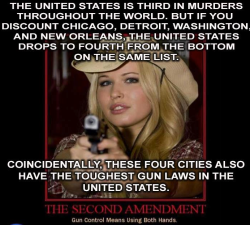
My friend, Jim Babka, of Downsize DC and a gun owner and strong gun rights supporter commented on Facebook that he wished memes came with sources. This is a meme I’m sure he’d like to be true, but he’s expressing his doubt. And with good reason, as I’ll show.
Two caveats before I begin. First, since the meme does not say whether it’s talking about murder rates or total murders, I’ll report both. But murder rate is the only number that really matters. China, with almost 1.4 billion people, could have 100,000 murders per year and have a murder rate of 7.1 per 100,000 people, while Iceland, with 323,000 people, could have just 100 murders per year and have a far higher rate at 31 per 100,000 people. Comparing total murders doesn’t tell you as much about how dangerous a country is as its murder rate.
Second, the data I’m using comes from multiple years and multiple sources, so my conclusions are false in their apparent precision. But more unified data could not plausibly be different enough to change the general conclusion. So here goes.
The United Nations Office on Drugs and Crime (UNODC), as reported by Wikipedia, lists the U.S. as 121st worst in “intentional homicide” rate, at 3.8 per 100,000 population, and 12th worst in total murders, at 12,253 (data from 2013). The data come, variously, from years between 2009 and 2013 inclusive, so for any given year that might go up or down a little bit.
The FBI’s 2014 crime report claims a murder rate of 4.5/100,000, which would put the U.S. at 113th in the UN ranking, and total murders at 14,294, which would put the U.S. at 9th in total murders, both slightly worse than the UNODC rankings.
But whichever data set we use, the U.S. is not 3rd in murders as the meme claims. Strike one.
Now about those cities. They’re strange choices because they’re not the top 4 in total murders in the U.S., which, using the FBI report’s city-level data on “Murder and nonnegligent manslaughter” (which will be a slightly higher number than just murder), would be 1) Chicago, 2) New York, 3) Detroit and 4) Los Angeles. Instead of NYC and LA the meme substitute 9) New Orleans and 15) Washington. Odd, but ok, since it actually makes the meme’s estimate more conservative, by excluding fewer murders. So it’s not that they’re cherry-picking, it’s just that it’s more evidence the meme is just made up by someone not looking at any real data.
Now we can subtracting Chicago’s 411 “murders and nonnegligent homicides, Detroit’s 298, New Orleans’ 150, and Washington’s 105 (all from the FBI report) from the national total of murders we’re left with 13,330 total murders in the U.S. Note that “murders and non-negligent homicides” is a greater number than just murders, so if we’re just interested in murders–the term the meme uses (although I doubt they were trying to be precise in their legal terminology)–we’re subtracting extra non-murder deaths from the total murder rate, overstating the effect of removing those cities from the national murder count, which works in the meme’s favor. And yet 13,330 murders nationally would only drop the U.S. from 9th on the UNODC list(using the FBI’s data) to 11th, still above the UNODC’s ranking of the US at 12th.
But what about the more important murder rate? The U.S. population minus the population of those four cities is 314,842,406. Dividing the 13,330 murders in the rump U.S. by that population, gives a murder rate of 4.2/100,000, or tied for 115th (with Cuba and Tuvalu). Working up from the countries with the lowest murder rate, eliminating those four cities’ murder rates would put the U.S. 103rd from the bottom. Maybe they just kept the 3 and dropped the 100? Strike two.
In short, eliminating those four cities does improve the U.S.’s world ranking in homicide, but not by much.
Both in passing and in conclusion I’ll note that the girl in the picture appears to have both fingers in the trigger guard. Strike three.
[This is a multi-part series. See parts I and II.
Note: This entry in the series immediately follows the previous entry. I strongly recommend a quick review of part II to re-establish the mood and setting.]
______________________________
“Don’t pick up any black people, especially if there’s more than one of them,” the experienced cabbie told me. “Stay out of Third Street, and Bayview/Hunter’s Point. Don’t stop for anybody there”
I’d stopped after midnight for a passenger on Market Street, who’d turned out to be a young black male, and then two young black males, and they’d taken me down Third Street to Bayview/Hunter’s Point, into a deserted warehouse district, where I expected to die, only to drop them off at the San Francisco Naval Shipyard: two sailors who’d thanked me and tipped me well.
Chagrined, but still shaking off the stress of believing I was about to be shot point blank in the back of the head, I was headed back up Third Street to familiar territory.
“Stay out of Third Street, and Bayview/Hunter’s Point. Don’t stop for anybody there”
I’m not going to.
Stopped at a traffic light, I see a guy wave at me from across the intersection. Black, middle-aged, wearing a Muni uniform, a bus or streetcar driver, maybe the cable cars.
I’m not going to be that guy, and a middle aged bus driver surely can’t be a threat, unless he’s behind the wheel and I’m on my bike. The light changes, I roll forward and stop in front of him.
He’s in a good mood, relaxed, smiling and friendly. He gives me directions, and I recognize the hill we’re going up. It’s the route toward my friend’s home in the feudalistic white enclave above the poor black peasants.
As we skirt around the top of the hill we pass an open grassy area, on fire. Sometime past one o’clock in the morning, and there is a grass fire, and there is nobody around. Weird. We’re both silent.
We descend the hill, heading down toward the Bay, heading through the projects. I’d heard about these projects, World War II temporary housing for shipyard workers still in use a half century later. I make a sharp left, an acute angle, into a narrow dead-end street. There’s a trash dumpster, flames boiling from its depths into the dark sky, with people sitting around it in chairs, drinking and talking. It’s surreal, and coming so soon after I thought I was about to be shot point blank in the back of the head and after passing the grassy lot burning with no one around it’s too much for me to process.
They’re calling out to me. “Cabbie, hey, cabbie! Beautiful night, isn’t it?” The man pays me and gets out. The street is so narrow I have to back up and pull forward a couple of times to make the turnaround, a 5 point turn. All the while these strangers drinking deep into the night by the light of a burning dumpster are calling out to me. I’m freaked out. This doesn’t happen in small midwestern farm towns. This doesn’t happen in the small town where I want to the small conservative religious college. It doesn’t happen in my neighborhood in San Francisco. I wave, trying to seem friendly, trying not to seem rude…trying not to seem racist…and drive out as fast as I decently can.
“Don’t stop for anybody there”
Believe me, I’m not going to. The sailors turned out to be all right, the Muni driver was friendly and pleasant, but the circumstances were just too freaky. I’m getting out of there as fast as I can, back on Third Street charging north towards downtown, north of the speed limit.
An arm waving, a middle-aged lady, nicely dressed. I’m not going to be that guy. I’m not that guy. And I’m not going to leave a woman without a ride in the middle of the night.
First a stop at a nearby liquor store where I idle in the parking lot while she buys a bottle of wine, then then on to her home. No problem. She’s nice, chatty, friendly. The route home is familiar. I’d been there just minutes before.
We skirt the edge of the hill. The grassy lot is still burning, but thank you god firetrucks have just arrived, restoring some semblance of normalcy to this increasingly crazy night.
Back down the same street towards the Bay, the same acute left turn into the same narrow dead-end street of WWII temporary shipyard housing still occupied a half century later, past the same burning dumpster, past the same people sitting around it drinking.
It’s been 15 minutes, tops, since I was there before. They recognize me and they’re calling out to me again, “The cabbie’s back!” Hey, cabbie!
Deja vu, but it’s real, surreally real. I make my 5 point turn again, wave again, heart racing, drive off as fast as I decently can again, get to Third Street again, turn north toward downtown again, toward familiar territory, toward the cab shop because while I could have the cab a couple more hours I’ve made decent money for my first night, and I’m now so freaked out by the weirdness of the night to want to drive anymore at all.
I have tunnel vision. I don’t know if anybody is trying to flag me down or not. All I can see is pavement ahead of me. Every light I hit green or yellow and blow on through. I cross Mission Creek, back into the South of Market area, and head back to the shop.
Arriving home, I find my girlfriend has waited up for me, scared, expecting me home a couple of hours ago. I tell her I meant to drive until 4, for the full 12 hours I had the cab. Then I tell her about my night, my first night as a cab driver, and together we relive the craziness of it; a hell of a night, never to be equalled in the four months I drove.
________________
Post-script:
Long after, I realized what an opportunity I missed. Had I gotten out of the cab, walked over, and shared a drink with them, I would have earned the respect of those folks sitting around the burning dumpster: a white guy, getting out of his cab in the projects, at nearly 2 a.m., to share drinks with black people living there. I imagine they laughed about me–I do, too, now.
What makes me kick myself is that inside, I knew it. I could tell their calls to me, while slightly mocking, were friendly, not threatening. They would have loved it if I hadn’t acted like the scared kid I was, but had joined them. I regret that moment.
[This post is part of a series. Part I is here.]
“Don’t pick up any black people, especially if there’s more than one of them,” the experienced cabbie told me. “Stay out of Sunnydale, Third Street, and Bayview/Hunter’s Point. Don’t stop for anybody there”
It was my first day, we were playing pool on the immense 9′ long and slow rolling pool table that appeared to suspend the laws of gravity and friction in order to prove Newton’s first law of motion. No matter how slowly the balls rolled, they kept going until they reached the other bumper far far away. And between shots he was giving me tips on making money and staying alive as a cabdriver.
I didn’t want to be that guy. I remembered Clarence Thomas during his confirmation hearings talking about how hard it was for him to get a cab in D.C., and thinking no matter what kind of person he might be personally, that wasn’t right. And I knew I’d have no trouble stopping for a professionally dressed black person, or an older black person. But…
I was only a couple years removed from my no-stoplight Midwestern farm town, and my safe little religious college. And I knew that cabbies had the highest homicide rate of any profession, mostly from getting shot in the back of the head without warning, mostly at night, the shift I’d chosen. And only a year and a half before I’d gotten jumped and beaten while riding my bicycle through the projects. It had been tough working through my fear of young black men afterward. When I heard footsteps behind me at night, I would tense up and turn, and I would relax if I saw anyone other than a young black male. And because I had friends who were young and black, I like I was insulting my friends every time I did that, so I consciously worked on overcoming that fear, and did so pretty successfully, mostly by telling myself that’s guy’s probably as nervous about me as I am about him.
But as a cabbie? Young black males, particularly in groups, particularly if they were dressed a certain way? I wasn’t sure if I’d pick them up. (more…)
I didn’t really want the job, but I’d been looking for a while, and I couldn’t ask my girlfriend to keep covering my share of the rent. And reportedly it was good money, if dangerous.
.
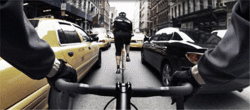 I had been a bike messenger, and was proud of it. But I’d taken a summer off to work in Yellowstone, and while hiking on Electric Peak scorched by the fires of ’88, my foot slid in the deep ash and I went down with my kneed twisted under me.
I had been a bike messenger, and was proud of it. But I’d taken a summer off to work in Yellowstone, and while hiking on Electric Peak scorched by the fires of ’88, my foot slid in the deep ash and I went down with my kneed twisted under me.
The pain was immediate, the knee unable to bear my wait, and I was alone, three miles from my car. The hike out was excruciating, as was every hike I tried to take the rest of the summer, particularly the foolishly agreed to hike along Sky Rim trail, when my brother threatened to kill and eat me if I died, and which ended with a long steep downhill I managed by throwing my left leg forward and dragging my right leg up, one lunge at a time, for mile after mile.
But by the time I made it back to San Francisco–after sadly breaking up with my summer girlfriend, trying unsuccessfully to move to Missoula, Montana, and having the car I bought that summer blow the engine an hour out on the drive from Missoula to to San Fran–I could walk on flat ground again, and I went back to the messenger shop and got on my bike.
I soon had a new girlfriend, a new apartment with her, and the beginning of a long happy life together, but the same old pain. Every day on the bike was excruciating, and finally I was forced to quit. My friend Jake had called me a lifer. I lasted two years.

I found out that nobody wanted to hire a former bike messenger. Our reputation preceded me. So cabbie it was, an occupation that, like messengering, had a handful of long-timers but a lot of turnover among those who tried it out and found it wasn’t for them. I remembered suppressing a sneer at a former roommate who’d been a bike messenger for half a day. Karma–I was a cabbie for a whole three months, hating the job every day, hating urban driving, hating drunks in my cab, hating the fat slob of a dispatcher for his sneering superiority and for assigning us low guys in the hierarchy the shittiest most poorly maintained cars in the shop, hating having to arrive at 2 p.m. and wait around up to two hours waiting for my name to be called for an available car, hating the feeling that I was a college dropout who couldn’t get a better job.
The other cabbies were pretty good guys, though, at least the ones who bothered to talk to me. One was a former bookstore owner, who found it hard to get a better job because nobody wanted to hire someone who’d been their own boss, afraid they’d be unable to take orders from someone else. Another like to play a game of pool before heading out, on the shop’s monstrously long table, where the balls rolled mysteriously slowly, but rolled on and on an on, in apparent defiance of the laws of physics.
And they generously gave me tips on the job: avoid the airport–you’ll get big fares, but the long wait times aren’t worth it; ignore the radio calls and stick to areas where people are likely to flag you down; if you get a drunk asshole in your cab, drive to the nearest police station; stay out of Hunter’s Point, Bayview, Third Street, Sunnyside; don’t pick up black people.
Some of the advice I took, some I didn’t.
And I have a few stories I will tell.
[Image credits:
- Bike Messenger: http://www.gibsonpictures.com/MoreBikeMessengerAndCommuting.jpg;
- Electric Peak: “Electric-peak-trees”. Licensed under Public Domain via Wikimedia Commons – https://commons.wikimedia.org/wiki/File:Electric-peak-trees.jpg#/media/File:Electric-peak-trees.jpg
- Skyrim Trail: http://www.spiriteaglehome.com/cdt06%20images/WY220%20Sky%20Rim%20Trail.jpg
- Apartment House: Google.
- Cab: http://img.sfbay.ca/home/wp-content/uploads/2014/09/taxi-788×563.jpg
- Cab staging area, SFO: http://ww3.hdnux.com/photos/33/24/06/7160226/5/920×920.jpg]
Problem: Dogs like to look out the window, but are too short to do so without standing on their hind legs.

Solution: Build a window seat for canines.
So my wife asked, “Do you think you could build a bench so the dogs can sit and look out the window?” Why, of course I can. And what’s more, I have nearly all the materials I need right on hand, in the ridiculous amount of scrap lumber stored beside my shed, some from finished projects, some from projects that never got finished (or even started, beyond a trip to the lumber store), and some from the bunkbeds I built eight years ago and tore down last year. And so it began. (more…)
At the University of Michigan, a group of cowardly students forced the cancellation of a showing of the film American Sniper, claiming it “promotes anti-Muslim…rhetoric” and “create(s) an unsafe space that does not allow for positive dialogue.” Although I have not seen the movie, the various reviews I’ve seen make it clear that viewers are walking away from the film with different interpretations. Which is to say that it appears to be precisely the kind of movie that actively promotes critical thinking and creates an opportunity for students to engage in productive dialogue.
These efforts–too often successful–to preemptively foreclose debate because it might make some students uncomfortable seem to be growing in frequency. This is a disturbing trend. It’s different from the familiar habit of college administrators trying to squelch free speech because they want a nice, quiet, Stepford campus. This is college students demanding they not be exposed to ideas because they don’t want to be discomfited.
But that’s what education is about. We don’t learn unless we are made uncomfortable. The most well-educated person is the one who regularly reads those whose views are opposed to their own, who can make their intellectual opponents’ arguments as accurately–or even more so–than their opponents can, and who can accurately critique the weaknesses of their own perspective. There’s an old saying that a good research project is one in which you can believe the author’s mind could be changed.
This is the heart of the liberal arts ideal. By studying economics, my views on politics were challenged and changed. By studying anthropology and evolution, my understanding of human nature and the possibilities of human organization were shaped, which structured my views on politics. By studying psychology my perspective on the possibility of markets was refined.
If students refuse to be challenged, they will never become educated. If they run from debate by shutting it down, they will never hear challenges to their perspectives, will never learn the weaknesses of their ideas, will never learn to critically evaluate their beliefs, and will never learn to intellectually defend their understanding of the world around them.
In short, these students have rejected the ideal of the liberal arts education.
The liberal arts are a hard sell these days. People want to know how their course of study will lead to a job. All evidence is that a liberal arts education is a great basis for a broad range of careers, but perhaps too broad, because the direct connections may not exist. I can explain to students how a history major became an international shipping executive, or how an English Major ended up managing international supply chains, but the paths are so contingent, so unique and unrepeatable, that they provide little clear guidance. So students, or at least their parents, shy away from the liberal arts.
And of course careers matter, especially given the cost of college. But the reason the liberal arts are a good foundation for careers is because they train people to think and to learn, to incorporate disparate ideas from different fields and link them together to make sense of things. But not only do too few people see how that connects to careers, they no longer–assuming many people ever did–value critical thinking for itself, for its intrinsic value and the intangible value it adds to the individual’s life. They don’t value it for what it makes of a person.
This is the consequence: students who demand they not be challenged because it is uncomfortable, who demand intellectual safety over intellectual challenge, and who view their epistemic closure as right- thinking.
In the bigger picture this matters because a self-governing republic very well may require an educated populace: people who can think critically about different policy alternatives; citizens who can recognize that their own favored ideas are also imperfect; a public that can understand that vigorous public debate and open discussion of alternatives they dislike is not a threat to liberty but is the essence of liberty; a public that can accept electoral and policy losses without interpreting them as a sign of the system’s illegitimacy.
There is an irony for conservatives here. They have in many ways been at the forefront of the attack on the liberal arts, both because they don’t see enough monetary value in, for example, a theater degree, and because they object to the ways in which liberal academics have challenged their world view and made them uncomfortable. And now there are an increasing number of liberal students taking up that cause and making the same demands, but about conservative views.
And there is also an irony for liberals. In the 1960s liberal students fought for the right to freely discuss and learn about challenging ideas–they fought for intellectual openness. Today liberal students fight against free discussion and teaching of challenging ideas–they fight for intellectual closure.
The American academy is deeply imperiled by a host of factors, including rising costs, a public that doesn’t appreciate what education really does for a person, professors who don’t think it’s their job to teach the public that value (while sneering at them for not understanding it), anti-intellectual administrators, and accrediting agencies that impose ever more inflexible standards that undermine creativity and experimentation in teaching. If the idea of education is assaulted by the students as well, our last best hope for an educated public may disappear.
[Co-published at the Bawdy House]
President Obama has suggested that mandatory voting could offset the influence of big money in campaigns. There’s much that is incoherent in this idea.
First, Democrats are doing as well as Republicans in bringing in big money, but their own electoral failure demonstrates big money itself does turn elections.
Second, the non-voters are generally the least engaged,* who presumably are the most likely to be easily swayed by the advertising of big money, or else might vote essentially randomly.
Third, mandatory voting is illiberal. Forced political participation is another form of social control, rather than a form of liberty. Thorouean types are forbidden. The quiet person who harms no one, pays her taxes without complaint, volunteers in the community, but prefers to not vote is made into a criminal.
Fourth, I object to the instinct to motivate people through punitive action. If as a public policy we want people to vote, then let’s look for positive ways to do so. Traditionally this is done via the parties. Voter mobilization is, in fact, one of the primary purposes of parties, and perhaps the primary purpose.
Fifth, Obama is suggesting that these people should vote for their own good. Mandating that people act in their own interest is perverse, and in my view an improper task for government.
Sixth, it’s not at all certain that big money actually deters turnout, rather than stimulating it.
Overall, it appears to me that the President is concerned about Democratic voter turnout specifically, under the guise of being concerned about overall electoral turnout. He specifically mentioned low turnout among young, lower income, immigrant and minority groups, and criticized efforts to deter their turnout. While it’s fair to argue that efforts to deter turnout are a legitimate public policy problem, the fact remains that Obama is particularly focused on low turnout among populations that he expects to be more supportive of his party, so his solution is not to strengthen his own party’s GOTV efforts, or to find ways to effectively combat voter suppression efforts, but to mandate voting by his party’s likely supporters. Even if successful, though, the lack of close races suggests mandatory voting would have little effect on outcomes.
Under the guise of public policy, this appears to be a means of using law to rig the vote in the Democrats’ favor, no less than voter ID laws are (unsuccessful, I think) efforts to rig the vote in Republicans’ favor, and again under the guise of public policy.
Politicians will normally obscure self-interest behind appealing public interest slogans. They do so because it works, which means appeals like my post here to ignore the slogans will only be effective at the margins.
_____________
*Not solely. I have not voted when I have disliked the options, and I have had a political scientist far more reputable than me assert he gives money rather than voting because it gives his effort more influence.


